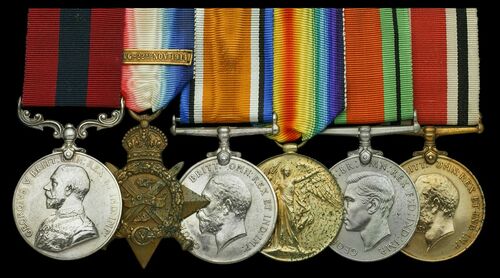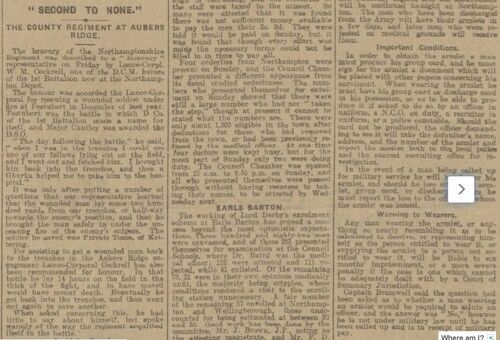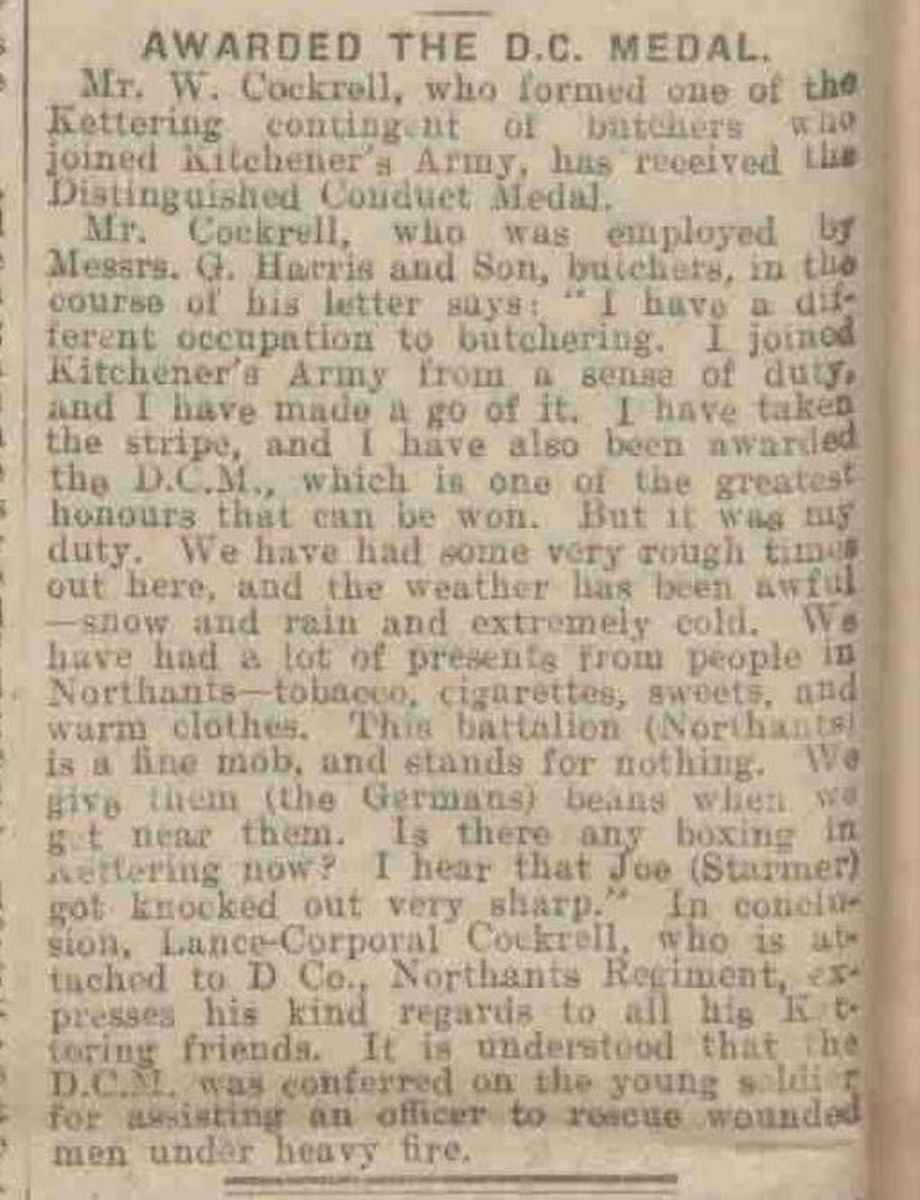Auction: 23003 - Orders, Decorations and Medals
Lot: 284
'The Brigadier-General desires to take this opportunity of congratulating 'D' Company of the 1st Battalion, Northamptonshire Regiment, on its gallant and steady behaviour during the action of 22nd December [1914]. The manner in which it resisted the German counter-attack, and the steadiness with which it finally withdrew in the face of superior numbers, and eventually occupied a position in rear to cover the gap made in the line, was worthy of all praise and adds fresh laurels to the fine record of the old 48th.'
The Special Brigade Order issued by Brigadier-General Westmacott, upon hearing of the performance of 'D' Company at La Quinque Rue
A fine '1914 Winter Operations' D.C.M. group of six awarded to Private W. M. Cockrell, 'D' Company, 1st Battalion, Northamptonshire Regiment, for his gallant conduct at La Quinque Rue on 22-23 December 1914, when he went out 200 yards beyond the trenches to rescue a severely wounded man whilst exposed to heavy rifle and machine gun fire
Distinguished Conduct Medal G.V.R. (10068 Pte W. Cockrell. 1/North: R.); 1914 Star, clasp (3-10068 Pte W. Cockrell. 1/North'n R.); British War and Victory Medals (3-10068 Pte. W. Cockrill. North'n. R.); Defence Medal 1939-45; Special Constabulary Long Service, coinage head, (William Cockrill), note surname on last three, good very fine (6)
D.C.M. London Gazette 1 April 1915:
'For gallant conduct on 23rd December,1914, during an engagement near Bethune when he went out 200 yards in front of his trench and assisted in the rescue of a wounded man, whilst exposed to heavy fire.'
William Morris Cockrell was born on 17 May 1893 in the Parish of St James's, Colchester, the son of William and Louisa Cockrell. The family are recorded in the 1901 Census, residing at Pimlico Cottage, Harwich Road, Colchester, where Cockrell senior is recorded as an 'Engineer's Assistant'. Recorded again as an adult in the 1911 Census, living as a Boarder at 8 Crawley Road, Luton, where his own occupation is given as 'Butcher's Assistant'.
Cockrell's military service record confirms that he enlisted in the 3rd (Reserve) Battalion, Northamptonshire Regiment, at Northampton, on 10 August 1914; declaring his age to be 21 years and his trade as 'Butcher'. On declaration of war, the 3rd Battalion was stationed at Northampton and began to implement its primary task of equipping and dispatching reservists to the 1st Battalion, which had been assigned to the 2nd Infantry Brigade, 1st Division, and was stationed at Aldershot. Posted to the 1st Battalion, Cockrell entered the France and Flanders theatre of war as part of a late draft, on 12 November 1914.
He was recommended for the award of the Distinguished Conduct Medal for his conspicuous gallantry at La Quinque Rue, near Le Touret, on the night of the 22-23 December 1914, when he went out 200 yards in front of his trench and assisted in the rescue of a wounded man whilst exposed to heavy fire. The award of the D.C.M. was announced in the supplement to the London Gazette dated 18 February 1915, and the citation published in the supplement dated the 1 April 1915.
The circumstances of the attack, and Cockrell's 'D' Company's role, are recorded in the Regimental History:
'At 9am on the 20th December, the enemy exploded ten small mines beneath the Indian Corps trenches in front of Givenchy, followed immediately by infantry attacks, with much bombing, on Givenchy and the front northwards of the hamlet of La Quinque Rue. The trenches either side of Givenchy were lost, but the 1st Manchester Regiment was still in possession of Givenchy. The extent of the attack can be assessed by the German claim that 19 British officers, and 815 other ranks were taken prisoner.
GHQ ordered three infantry brigades to be sent to assist the Indian Corps. The 1st (Guards) Brigade reached Bethune at 3am on the following day (21st), followed by the 21st Brigade at 7.30am. At noon, both brigades moved to the attack. The 1st (Guards) Brigade was to attack with its left on Givenchy, and the 21st Brigade with its right on the village, which was still being held by the 1st Manchesters. The 2nd Infantry Brigade reached Le Touret at 3pm, and was immediately ordered to retake the left sector of the Indian front near 'The Orchard', about a mile north-east of Festubert, which had been lost that morning.
The three brigades were delayed in heavy water-logged ground by machine-gun fire, and it was dark before they reached the neighbourhood of Givenchy, which the 1st Manchesters, practically surrounded had just evacuated. The attack was launched at 7pm, with 'A' and 'D' Companies forming the leading waves of the Northamptonshire Regiment, but whilst the greater part of the lost trenches were recovered, 'D' Company had suffered severely.
During this counter-attack, the 1st (Guards Brigade) recovered the village, and most of the lost trenches were retaken. However, a length of trench on the left, in front of Festubert was not recovered, and the isolation of the three brigades in the dark made the position difficult.
The trenches re-taken by the Northamptons were then garrisoned by the 1st Battalion Loyal North Lancashire Regiment, whilst the Northamptons, less 'D' Company, returned to billets, a mile in rear. 'D' Company, which was commanded by Major W. O. Cautley, remained to complete the left of the line.
A short time later, the enemy counter-attacked, forcing the Loyals from their trenches, and creating a dangerous breach in the line. After a fierce resistance, Major Cautley decided to withdraw 'D' company some 600 yards to a line of trenches in rear, as he was in danger of being surrounded. He succeeded in holding this trench with support of men from various units. Immediately following the enemy counter-attack, the three remaining Northamptonshire companies took up a position in support of 'D' Company, in order to cover the breach made in the line, remaining there until relieved by 4th Brigade, after nightfall on the 23rd December'.
The Battalion War Diary (WO/95/127/1-1) summarised the day's action as follows:
'22nd December - received news about 9 am that the enemy had attacked and broken through. Our three companies ('B', 'C', and 'A') were at once ordered up to support. It was found that the enemy had driven back the line some 33 yards. It was found, however, that the forward line held the previous night was untenable so a line was taken up about 300 yards in rear. Our 'D' Company was very highly congratulated on its fine resistance by the Brigadier General commanding 2nd Infantry Brigade. This line was held by the Battalion during the day with no difficulty. Major Cautley received the DSO for the great work he did this day and 2/Lieutenant Fulton the Military Cross. Two DCM's were also given to men'.
The award of Cockrell's D.C.M. was locally reported in the Chelmsford Chronicle dated 29 January 1915 as follows:
'COLCHESTER CORPORAL'S D.C.M:
Mr. W. J. Cockrell, landlord of the Whalebone Inn, Colchester, has received a letter from his eldest son, Corp. W. Cockrell, 1st Northampton Regt., who says: "You will be pleased to hear I have got the D.C.M. and a pension of sixpence a day. I am in the best of health, and not much the worse for wear. I am going back to the trenches tonight, so excuse a short note. Give my kindest regards to Arthur...".'
The first day of the Battle of Loos, 25 September 1915, Cockrell was overcome by gas poisoning, one of the 372 casualties his Battalion suffered during the day. Evacuated to England on 20 October 1915, he was interviewed by a reporter from his local newspaper, the 'Northampton Mercury', and the following article was published on 17 December 1915:
'SECOND TO NONE - THE COUNTY REGIMENT AT AUBERS RIDGE - The bravery of the Northamptonshire Regiment was described to a "Mercury" representative on Friday by Lance-Corporal W. M. Cockrell, one of the DCM heroes of the 1st Battalion now at the Northampton Depot. The honour was accorded the Lance-Corporal for rescuing a wounded soldier under fire at Festubert in December of last year. Festubert was the battle in which D Company of the 1st Battalion made a name for itself and Major Cautley was awarded the DSO. "The day following the battle", he said, "when I was in the trenches I could see one of our fellows lying out on the field, and I went out and fetched him. I brought him back into the trenches, and then a Ghurka helped me to take him to the hospital".
It was only after putting a number of questions that our representative learned that the wounded man lay some two hundred yards from our trenches, or half-way towards the enemy's position, and that he brought the man safely in under the unceasing fire of the enemy's snipers. The soldier he saves was Private Toms of Kettering. For assisting to get a wounded man back to the trenches in the Aubers Ridge engagement, Lance-Corporal Cockrell has also been recommended for honour. In that battle he lay fourteen hours on the field in the thick of the fight, and to have moved would have meant death. Eventually he got back into the trenches, and then went out again to save another. When asked concerning this, he had little to say about himself, but spoke warmly of the way the regiment acquitted itself in the battle.
AS IF ON PARADE - "From the way the men came out of the trenches", he said, "and went forward, keeping their lines and led by their officers, they might have been on a ceremonial parade instead of facing the deadly fire which mowed them down. I've never seen anything equal to it: it thrills me to think of it. When 'A' Company sprang out, 'B' and 'C' Companies took their places in the trenches, and then, in their turn, they went forward. Everything seemed to work like clockwork. It was almost an impregnable position, and the machine-gun fire was too strong for us, but no one who saw it can ever forget or cease to admire the way our men knowingly went out to meet an almost certain death".
Talking of the Battle of Loos, where he was "gassed", he said, "We had a sporting chance there, and we shifted the Germans. It was surprising how much heart it gives you to see the Germans on the run". Lance-Corporal Cockrell's home is at Colchester, but before enlisting he was working for Mr Bernard Harris, butcher.'
Cockrell re-joined his Battalion on 19 July 1916, but within a month of his return to duty, he received gunshot wounds to the right arm and hand, during the attack on High Wood on 20 August 1916. His wounds on this occasion were treated in France, but on 28 June 1917, he suffered a fracture to his left leg whilst on duty and evacuated to England.
Discharged the service on 22 February 1918, Cockrell was listed as 'being no longer physically fit for War Service' in accordance with Paragraph 392 (xvi), King's Regulations; his character on discharge stated as 'excellent'.
He was awarded Silver War Badge No 320903, which was authorised on 9 February 1918. Despite his late entry into France, Cockrell successfully applied for the Clasp to his 1914 Star, which was issued to him with his 1914 Star and other campaign awards on the 31 May 1921.
After his discharge, Cockrell worked for Colchester City Council as a Park-Keeper. He also joined the Special Constabulary in Colchester, and was awarded the Special Constabulary Faithful Service Medal. Marrying Vera May Bailey at Strood, Kent, in 1919, and the couple are recorded in the 1939 Register, residing at 82 Bryant Road, Rochester, where Cockrell's occupation is given as 'Anodic Operator'. Cockrell died at Chatham, Kent in 1982; sold together with an archive of original material comprising:
i)
Discharge Certificate.
ii)
Character reference on discharge.
iii)
Birth Certificate.
iv)
School character reference.
Subject to 20% VAT on Buyer’s Premium. For more information please view Terms and Conditions for Buyers.
Sold for
£950
Starting price
£800









